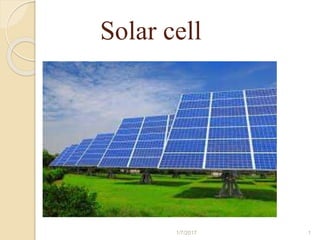
solar_cell_pptx.pptx
- 2. Contents.... Definition …explanation ………..1 History …………………………..2 Types of solar cell…….………….3 Structure of solar cell.……………4 Working and construction of solar cell….5 Material using for the production……….6 Research in solar cell………………..….7 Advantages and disadvantages …………8 1/7/2017 2
- 3. What is solar cell: A device converting solar radiation into electricity. Solar power: Solar power is the conversion of sunlight into electricity, either directly using photovoltaics (PV), or indirectly using concentrated solar power. Concentrated solar power systems use lenses or mirrors and tracking systems to focus a large area of sunlight into a small beam. 1/7/2017 3
- 4. History of solar cell 1839: Photovoltaic Effect Is Discovered. French scientist Edmond Becquerel first discovered the photovoltaic effect in 1839. This process occurs when light is absorbed by a material and creates electrical voltage. Most modern solar cells use silicon crystals to attain this effect. 1/7/2017 4
- 5. Types of solar cell •Amorphous Silicon solar cell (a- Si) •Concentrated PV cell (CVP and HCVP) •Crystalline silicon solar cell (c- Si) 1/7/2017 5
- 6. Structure of solar cell A solar cell is an electronic device which directly converts sunlight into electricity. Light shining on the solar cell produces both a current and a voltage to generate electric power. This process requires firstly, a material in which the absorption of light raises an electron to a higher energy state, and secondly, the movement of this higher energy electron from the solar cell into an external circuit. The electron then dissipates its energy in the external circuit and returns to the solar cell. 1/7/2017 6
- 7. Working of solar cell The main part of a silicon (Si) solar cell generating solarpower is formed by two differently doped (n- and p-) silicon layers. A physical barrier is created between them along the p-/n- junction, with electrons and holes diffusing into regions of lower concentration. 1/7/2017 7
- 8. Research in solar cell Nanocrystalline solar cell Thin film processing Multi junction solar cell Polymer processing Nano particle processing 1/7/2017 8
- 9. Research in solar cell Transparent conductors Silicon wafer-based solar cell Infrared solar cell UV solar cell 3D solar cells 1/7/2017 9
- 10. Research in solar cell Nanocryatalline solar cell: These structures make use of some of the same thin-film light absorbing materials but are overlain as an extremely thin absorber on a supporting matrix of conductive polymer or mesoporous metal oxide having a very high surface area to increase internal reflections • Thin film processing: Thin-film photovoltaic cells can use less than 1% of the expensive raw material (silicon or other light absorbers) compared to wafer-based solar cells, leading to a significant price drop per Watt peak capacity • Multijunction solar cell It represents a new class of solar cells with clear advantages in performance, engineering design, operation and cost. Their performance and cost effectiveness is constrained by growing the cells in an upright configuration 1/7/2017 10
- 11. Research in solar cell: • Polymer processing The invention of conductive polymers may lead to the development of much cheaper cells that are based on inexpensive plastics. • Nano particle processing: Experimental non-silicon solar panels can be made of quantum heterostructures, e.g. carbon nanotubes or quantum dots, embedded in conductive polymers or mesoporous metal oxides. • Transparent conductors Many new solar cells use transparent thin films that are also conductors of electrical charge. The dominant conductive thin films used in research now are transparent conductive oxides (abbreviated "TCO"), and include fluorine-doped tin oxide (SnO2:F, or "FTO"), doped zinc oxide (e.g.: ZnO:Al), and indium tin oxide (abbreviated "ITO"). 1/7/2017 11
- 12. Research in solar cell • Silicon wafer-based solar cell: A large body of research is being done all over the world to manufacture silicon wafer-based solar cells at lower cost and to increase the conversion efficiencies without an exorbitant increase in production cost. • Infrared solar cell: Researchers at Idaho National Laboratory, along with partners at Lightwave Power In. in Cambridge, MA and Patrick Pinhero of the University of Missouri, have devised an inexpensive way to produce plastic sheets containing billions of nanoantennas that collect heat energy generated by the sun and other sources • UV solar cells: Japan's National Institute of Advanced Industrial Science and Technology (AIST) has succeeded in developing a transparent solar cell that uses ultraviolet (UV) light to generate electricity but allows visible light to pass through it 1/7/2017 12
- 13. Advantages & disadvantages Advantages 1…It uses renewable energy source. 2…It produce electricity which does not cause pollution. 3…It can be use in remote areas. 4…Reduce consumption of fossil fuels in the production of electricity. 5…Reduce production of green house gases as CO2. Disadvantages 1…It uses a special grade of silicon which is expensive. 2…Current produce in the form on DC. 3…silver is use in the production which is expensive metal. 4…Interfere with natural flow of water. 5… Requires maintenance . 1/7/2017 13
- 14. References: Nohira T, Yasuda K, Ito Y (2003). "Pinpoint and bulk electrochemical reduction of insulating silicon dioxide to scon". Nat Mater. 2 (6): 397–401. Jump upJin X, Gao P, Wang D, Hu X, Chen GZ (2004). "Electrochemical preparation of silicon and its alloys from solid oxides in molten calcium chloride". Angew. Chem. Int. Ed. Engl. 43 (6): 733– 6. doi:10.1002/anie.200352786. PMID14755706 ^ Jump up to: "Sliver Technology Research at the Australian National University”. Jump up M. A. Green, "Consolidation of Thin-film Photovoltaic Technology: The Coming Decade of Opportunity," Progress in Photovoltaics: Research and Applications, vol. 14, pp. 383-392, August 2006. 1/7/2017 14